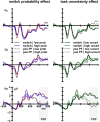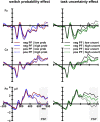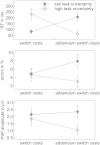Cognitive caching promotes flexibility in task switching: evidence from event-related potentials
- PMID: 26643146
- PMCID: PMC4672338
- DOI: 10.1038/srep17502
Cognitive caching promotes flexibility in task switching: evidence from event-related potentials
Abstract
Time-consuming processes of task-set reconfiguration have been shown to contribute to the costs of switching between cognitive tasks. We describe and probe a novel mechanism serving to reduce the costs of task-set reconfiguration. We propose that when individuals are uncertain about the currently valid task, one task set is activated for execution while other task sets are maintained at a pre-active state in cognitive cache. We tested this idea by assessing an event-related potential (ERP) index of task-set reconfiguration in a three-rule task-switching paradigm involving varying degrees of task uncertainty. In high-uncertainty conditions, two viable tasks were equally likely to be correct whereas in low-uncertainty conditions, one task was more likely than the other. ERP and performance measures indicated substantial costs of task-set reconfiguration when participants were required to switch away from a task that had been likely to be correct. In contrast, task-set-reconfiguration costs were markedly reduced when the previous task set was chosen under high task uncertainty. These results suggest that cognitive caching of alternative task sets adds to human cognitive flexibility under high task uncertainty.
Figures







Similar articles
-
Electrophysiological correlates of the cognitive control processes underpinning mixing and switching costs.Brain Res. 2016 Sep 1;1646:160-173. doi: 10.1016/j.brainres.2016.05.048. Epub 2016 May 26. Brain Res. 2016. PMID: 27238463
-
Switching between univalent task-sets in schizophrenia: ERP evidence of an anticipatory task-set reconfiguration deficit.Clin Neurophysiol. 2006 Oct;117(10):2172-90. doi: 10.1016/j.clinph.2006.06.716. Epub 2006 Aug 22. Clin Neurophysiol. 2006. PMID: 16926110
-
Components of switching intentional set.J Cogn Neurosci. 2002 Nov 15;14(8):1139-50. doi: 10.1162/089892902760807159. J Cogn Neurosci. 2002. PMID: 12495521
-
Task switching: interplay of reconfiguration and interference control.Psychol Bull. 2010 Jul;136(4):601-26. doi: 10.1037/a0019791. Psychol Bull. 2010. PMID: 20565170 Review.
-
The effect of age on task switching: updated and extended meta-analyses.Psychol Res. 2023 Oct;87(7):2011-2030. doi: 10.1007/s00426-023-01794-z. Epub 2023 Feb 2. Psychol Res. 2023. PMID: 36729159 Review.
Cited by
-
Cognitive flexibility and its electrophysiological correlates in Gilles de la Tourette syndrome.Dev Cogn Neurosci. 2017 Oct;27:78-90. doi: 10.1016/j.dcn.2017.08.008. Epub 2017 Aug 18. Dev Cogn Neurosci. 2017. PMID: 28863370 Free PMC article.
-
Event-Related Potential Responses to Task Switching Are Sensitive to Choice of Spatial Filter.Front Neurosci. 2018 Mar 8;12:143. doi: 10.3389/fnins.2018.00143. eCollection 2018. Front Neurosci. 2018. PMID: 29568260 Free PMC article.
-
The Wisconsin Card Sorting Test: Split-Half Reliability Estimates for a Self-Administered Computerized Variant.Brain Sci. 2021 Apr 21;11(5):529. doi: 10.3390/brainsci11050529. Brain Sci. 2021. PMID: 33919298 Free PMC article.
-
Changes in concentration performance and alternating attention after short-term virtual reality training in E-athletes: a pilot study.Sci Rep. 2024 Apr 17;14(1):8904. doi: 10.1038/s41598-024-59539-w. Sci Rep. 2024. PMID: 38632364 Free PMC article. Clinical Trial.
-
Cognitive flexibility and N2/P3 event-related brain potentials.Sci Rep. 2020 Jun 17;10(1):9859. doi: 10.1038/s41598-020-66781-5. Sci Rep. 2020. PMID: 32555267 Free PMC article.
References
-
- Kiesel A. et al. Control and interference in task switching—A review. Psychol. Bull. 136, 849–874 (2010). - PubMed
-
- Monsell S. Task switching. Trends Cogn. Sci. 7, 134–140 (2003). - PubMed
-
- Vandierendonck A., Liefooghe B. & Verbruggen F. Task switching: interplay of reconfiguration and interference control. Psychol. Bull. 136, 601–626 (2010). - PubMed
-
- Rubinstein J. S., Meyer D. E. & Evans J. E. Executive control of cognitive processes in task switching. J. Exp. Psychol. Human 27, 763–797 (2001). - PubMed
-
- Meiran N. Modeling cognitive control in task-switching. Psychol. Res. 63, 234–249 (2000). - PubMed
Publication types
MeSH terms
LinkOut - more resources
Full Text Sources
Other Literature Sources

